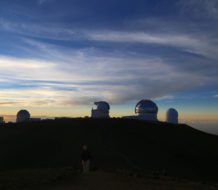In December 2015, particle physicists were buzzing with excitement: The Standard Model—which has dominated physics for 40 years and defines the basic constituents of matter and how they interact—had a new challenger. At the Large Hadron Collider in Switzerland, physicists announced evidence of what appeared to be a new particle. Known colloquially as the “diphoton bump,” the new particle promised to upend the Standard Model, which doesn’t predict its existence. It also opened the door to the possibility of solving long-unanswered puzzles, including the nature of dark matter.
About a month later, another potential challenger emerged. A group of nuclear physicists out of the Hungarian Academy of Sciences’ Institute for Nuclear Research published a paper on an anomaly detected in the decay of beryllium-8. They proposed that the irregularity could be the signature of a “dark photon,” one of the force carriers thought to dictate the action of dark matter.
On the surface, neither of these experiments might seem more viable than the other. Yet the response to each could not have been more different. While hundreds of theoretical papers were published on the “diphoton bump,” almost none followed the Hungarian paper.
What caused such a dichotomy? Though many factors have since been cited, including the reputation of the Hungarian scientists, it seems the true difference between these two experiments comes down to something subtler: Expectation, and divergence from those expectations.
Get BQO by E-mail
ESSAYS
-

What Is Moral Injury?
-

What Does It Mean to Have Free Will?
-

Should We Fear Robots?
-

Do We Need Purposes in Biology?






